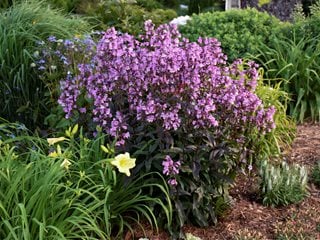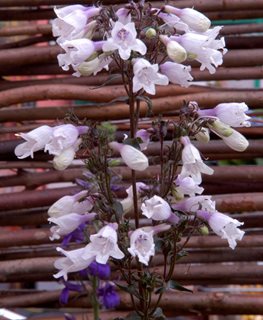How to Pick the Perfect Penstemon
With hundreds of varieties of this resilient native wildflower to choose from, there is a penstemon (beardtongue) ideal for almost any garden.If you’re looking for a high-impact, long-blooming perennial with low water requirements and amazing diversity, penstemon, or beardtongue, is a top contender. In early summer, right after your spring bloomers have faded, they fill the garden with spires of foxglove-like flowers in hues ranging from soft pinks and lavenders to bold, fiery reds and electrifying blues. In addition to offering a broad palette of colors, these native wildflowers and their many cultivars come in many shapes and sizes, from dwarf varieties you can tuck into rock gardens to waist-high prairie plants that bring color and movement to the back of the border.
On this page: Basics | Types | Growing Guide | Penstemon Pictures | Design Ideas
THE BASICS
Zones:
Varies depending on the species.
Plant Type:
Most penstemons are herbaceous perennials, but some hybrid strains are half-hardy and better suited for use as annual bedding plants.
Color and characteristics:
The most common flower colors are shades of blue, purple, pink, white and red, some with distinctive veining and white throats. The shape and color of the leaves vary depending on the cultivar. They can be oval, lance-shaped or needlelike with colors ranging from green or blue-green to deep purple. Related to foxgloves and snapdragons, a kinship evident in the vertical flower spikes and the flared, tubular blooms, which are perfect feeding stations for hummingbirds.
Height:
Varies widely. Some species are under 10 inches tall, while others can grow up to 6 feet.
Bloom time:
Early to midsummer
Length of bloom:
3 to 4 weeks or longer
Attracts:
For hummingbird lovers, they offer another important attribute. Because of their tubular nectar-rich flowers, they are one of the best garden perennials for attracting hummingbirds, according to The Hummingbird Society, rivaling salvias, columbines, honeysuckles and other hummingbird favorites. In addition to hummingbirds, the flowers attract bees, butterflies and other pollinators. For more, see The 24 Best Plants to Attract Hummingbirds
Special attributes:
- Drought and heat tolerant.
- Deer and rabbit resistant.
- Foliage of some species remains evergreen in mild climates.
Background:
Part of the plantain family (Plantaginaceae), penstemons are a huge genus of plants encompassing approximately 270 species and over 800 cultivars and hybrids. The name is derived from the Greek words penta and stemon, referring to the flower’s five stamens, four of which are fertile and one sterile. The pollen-free stamen (or staminode) protrudes from the flower and is covered by small hairs, thus the common name beardtongue.
TYPES
If you want to grow varieties that require the least amount of soil preparation and watering and will overwinter reliably, choose species that are native to your area and thrive in soil conditions and climates similar to yours. Although many are native to arid regions of the West and Southwest, almost every state in the continental U.S. has at least one native penstemon, demonstrating the amazing range of climates to which they are suited.
“The beauty and variability of penstemons have brought them to the forefront of home gardening, especially in areas subjected to droughts,” says Jennifer Bennett, author of Dryland Gardening. “There are so many good penstemons, with new ones coming onto the marketplace every year, that everywhere in North America, it is possible to grow at least one [type of] penstemon native to your area.”
These are some of the most adaptable and widely available choices:
Common beardtongue (P. barbatus):
A showy plant with erect spikes of 2-inch-long reddish-orange flowers and glossy lance-shaped leaves. Native to the Southwest, it grows best in dry climates. (Zones: 4-8; Height: 2 to 3 feet; Bloom time: June to September)
Foxglove beardtongue (P. digitalis):
Native to the northern Great Plains and northeastern states, this species is more tolerant of high humidity and moist soil than those of western origin. The elegant trumpet-shaped flowers are white or pale pink with the inner surfaces often marked by violet-colored nectar guides. (Zones: 3-8; Height: 3 to 5 feet; Bloom time: May to June)
Foothill penstemon (P. heterophyllus):
A California native with glossy blue-green leaves and blue flowers on slender spikes. Resistant to both drought and heat and will thrive on dry rocky slopes and hillsides. Cultivars include 'Blue Springs' and ‘Electric Blue’. (Zones: 6-10; Height: 1 to 1½ feet; Bloom time: May to June)
Firecracker penstemon (P. eatonii):
A native of California and the Southwest, with brilliant red hummingbird-magnet flowers and large, leathery evergreen leaves. (Zones: 4-8; Height: 1 to 3 feet; Bloom time: Early to midspring)
Pink snapdragon (P. palmeri):
One of the few that are fragrant, honey-scented light pink flowers are held high on spikes as tall as 6 feet. Native to southern California, Arizona and Utah, it thrives in arid climates and dry, sandy soils. (Zones: 5-8; Height: 3 to 6 feet; Bloom time: Late spring)
Pineleaf penstemon (P. pinifolius):
Loose spires of bright orange-red flowers and evergreen foliage that resembles tiny pine needles. Excellent species for dry rock gardens. Native to southern New Mexico and eastern Arizona. (Zones: 4-9; Height: 10 to 12 inches; Bloom time: Late spring to midsummer)
Mexicali hybrids (P. ×mexicali):
Mexicali penstemons are hybrids of Mexican species having large, showy flowers crossed with native North American species that exhibit good cold-tolerance. The range of flower colors cover the full penstemon spectrum. Two popular selections include rosy pink Red Rocks® and violet purple Pikes Peak Purple®. (Zones 5-9; Height: 12 to 18 inches; Bloom time: Early to late summer)
Rocky Mountain beardtongue (P. strictus):
Native to Wyoming, Utah and western Colorado, this blue-flowered species thrives in rocky or gravelly soil but adapts well to soils in many parts of the country. It’s also one of the longest-lived and one of the easiest to grow from seed. ‘Bandera’, a highly ornamental cultivar, offers the advantage of exhibiting greater tolerance for heavy clay soil. (Zones: 4-9; Height: 2 to 3 feet; Bloom time: Early summer)
GROWING GUIDE
Light preference:
Full sun to part shade. Varieties with purple or reddish leaves will exhibit the best foliage color when grown in direct sunlight.
Soil:
Penstemons do best in well-drained, slightly alkaline soil and will even grow in soils that are mostly sand or gravel. They are extremely sensitive to poorly draining soils and winter moisture. Planting them in raised beds or sloped areas will help them survive wet conditions. Ideally, the plants’ crowns should remain dry while the roots have access to a small but steady supply of moisture during the growing season. Avoid soil amendments that hold moisture, such as peat moss and manure.
Water requirements:
Although not as drought tolerant as cactus, many species do grow well in desert-like climates. The amount of water you’ll need to give them will often depend on the water-holding capacity of your soil and the origin of the varieties you have chosen. If you are growing species native to your area, you will rarely have to give them supplemental water after they become well established. Hybrids bred for garden conditions are not as drought tolerant as native species and may require watering during prolonged dry spells.
Growing from seed:
Many are easily grown from seed. Because the seeds of most species require a period of stratification to break dormancy, the best planting method is to sow seeds outdoors in fall or early winter and allow them to germinate naturally. Plant the seed at a depth of ¼ to ½ inch and keep the soil moist after planting for natural stratification to occur. It generally takes a year or two before seed-grown plants begin to bloom. For seed sources, visit the American Penstemon Society, which offers an online seed exchange program for members as well as a list of seed companies.
Propagating:
They tend to be short-lived plants and will often need replenishment after a few seasons. This can be done by taking softwood cuttings of nonflowering shoots in mid to late summer or by dividing plants in late winter or early spring. Many species will also self-sow freely.
Pruning and deadheading:
Penstemons need little pruning, but removing the stems after flowering is complete will often promote new foliage growth and a second flush of blooms. Deadheading will also prolong flowering, but be sure to leave a few seed heads on the stalks toward the end of the season so your plants can reseed.
Pests and diseases:
Although there are no serious threats, watch for root rot in poorly draining soils. Leaf spot, rust, powdery mildew, and Southern blight can also occur. Penstemons may be bothered by slugs or snails, and spider mites.
For more growing tips, including advice on purchasing nursery-grown plants and suggested varieties for beginners, read Growing Penstemons: Species, Cultivars and Hybrids, published by the American Penstemon Society.
PENSTEMON PICTURES
DESIGN IDEAS
- Native wildflower gardens
- Xeriscape gardens
- Rock gardens
- Perennial borders
- Container plantings
- Pollinator gardens
- Cut flowers
RELATED:
The Best Perennials for Pollinators
Top 20 Perennials for Pots
Drought-Tolerant Plants











